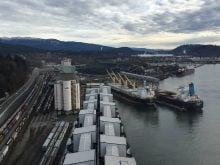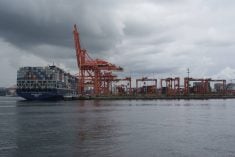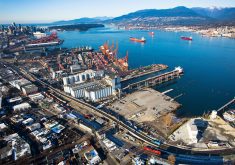Grain handlers with bulk terminals worry fees will be used for proposed container facility, but port says that’s not the case
The Vancouver Fraser Port Authority wants to clarify some misinformation circulating about its second Gateway Infrastructure Fee (GIF2).
It wants to quell the notion that the fee is to help pay for its proposed Roberts Bank Terminal 2 (RBT2) project, which is expected to cost more than $2 billion.
The new three-berth container terminal in Delta, B.C., is expected to increase the port’s container capacity by more than 30 percent.
Katherine Bamford, director of customer engagement with the port, wants to make it clear that the new fee has nothing to do with construction of the proposed RBT2 project.
Read Also

Short rapeseed crop may put China in a bind
Industry thinks China’s rapeseed crop is way smaller than the official government estimate. The country’s canola imports will also be down, so there will be a lot of unmet demand.
It is for building off-terminal transportation infrastructure, such as roads, rails, overpasses and underpasses all around the port to make it more efficient and competitive.
Examples include the rail upgrades completed last year as part of the Burnaby Rail Corridor Improvements Project on the North Shore and the new overpass that is part of the South Shore Access Project on the South Shore.
The new fees will help pay for 13 separate initiatives, some of which are complete, but most of which are either underway or being contemplated.
The total anticipated cost of the new transportation infrastructure is $1.13 billion.
The federal government is picking up $350 million of that tab through its National Trade Corridors Funds.
Industry will contribute another $380 million. The port is funding that portion in advance and then collecting 90 percent of it back by charging fees over the next 30 years.
The remainder of the program will be funded by railways, municipalities and other stakeholders.
The Western Grain Elevator Association is concerned that the industry portion of those fees are related to infrastructure that will have to be built to accommodate the RBT2 project.
Many WGEA members operate grain terminals at the port and will be paying the extra fees, which will trickle down to farmers through grain basis levels.
Those WGEA members move grain in bulk and are concerned about paying extra fees related to the containerized movement of various commodities.
Bamford said those concerns are misplaced. She noted that the port is composed of four trade areas.
“Users pay based on the benefits attributed to their trade area,” said Bamford.
The Roberts Bank Rail Corridor is paying 11 cents per tonne, the South Shore Trade Area 25 cents, the North Shore Trade Area eight cents and the Fraser River Trade Area 40 cents per tonne.
Bamford said terminal operators in the Roberts Bank Rail Corridor already paid for nine projects in the first round of GIF in the 2009-15 period.
“In the second GIF there are very few projects that are attributed to the Roberts Bank Rail Corridor,” she said.
That is why fees for that trade area are relatively low.
The WGEA is also concerned that the fees are being assessed on a per-tonne basis rather than per carload. They say that gives an advantage to container traffic over bulk goods.
Bamford said there were three rounds of consultations about the fees and stakeholders agreed that the fairest way to assess the fees is on a per-tonne basis, which is what the port did during the first round of GIF.
She noted that there are conversions for automobiles and for containers.
Perhaps the WGEA’s biggest concern is the apparent conflict of interest resulting from the port being both a project developer and a regulator.
Bamford said there are numerous examples of that model in federal, provincial and municipal governments.
She said the port is governed by the Canada Marine Act, which specifically gives ports that dual ability.
She noted that the model has been in place for decades and has worked well.
“It is part of how we’re structured deliberately,” said Bamford.
“It is a piece of legislation and it has resulted in unprecedented growth in our gateway to the benefit of Canadian exporters.”
















